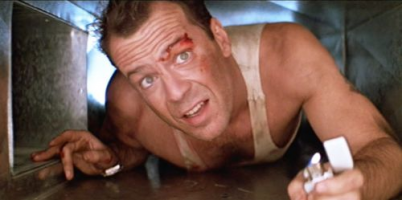Yikes
SAWHORSE
Starting a thread about how Hollywood portrays our industry. I'm going to lead off with a very old article from the LA Times, but feel free to add screenshots, YouTube clips, and pet peeves of what they get wrong - - and what movie or show you think came close to getting it right.
By TIM MERRILL
Feb. 13, 1994 12 AM PT
Freshman year: The architecture department at the University of Oregon has rounded up the movie that will show us what awaits us once we graduate. Of course, we’ve all read the book. We’re getting to the part where Dominique Francon is about to shed her dignity--and her clothes--as she did in the book, to convince Howard Roark just how much she believes in him.
OK, I admit to a little disappointment. “The Fountainhead” came out in 1949 and there’s no actual shedding of clothing. But it’s only a small letdown; I’m convinced I’m on the right track. Growing up in a small town, I had never met an architect, had never been in an architect’s office and had very little idea of what one did--I just knew I wanted to be one. I knew that they drew pictures of buildings, somehow had them built and were paid pretty decent money to do this. That left most of a lifetime’s bases covered.
But seeing “The Fountainhead” really crystallized things. Suddenly it was clear that you not only drew pictures and built buildings, but, if you were good enough at it, women threw themselves at you! What else could you ask of a profession? Just watching Patricia Neal longingly admire Gary Cooper’s muscled forearms was enough to buoy me through architecture school.
Decades of movie making since “The Fountainhead” did not produce another architect as leading man to rival Coop. I can recall only two films: “Don’t Look Now” (1973) and “Two for the Road” (1967), neither of which were box-office hits. For several decades, in fact, architects were forced to defer on screen to detectives, doctors, attorneys, cowboys, longshoremen and firefighters.
No more. Consider the recent flood of hunky cinematic architects: Wesley Snipes in “Jungle Fever,” Steve Martin in “HouseSitter,” Woody Harrelson in “Indecent Proposal,” Tom Hanks in “Sleepless in Seattle,” Jeff Bridges in “Fearless” and now Richard Gere in “Intersection.” Suddenly, architects are the yuppie leading man occupation of choice. And it’s probably no accident. The secrets of the appeal are plentiful:
In the same vein, Coop as Howard Roark said: “My work done my way--nothing else matters to me.” He blows up a building to prove it. Gere’s character in “Intersection,” unfortunately, reduces this noble passion to an expletive that, however tempting, is seldom directed on a real-life client.
He’s sexy yet sensitive. He’s professional yet casual. He’s a workaholic but still has time for the finer things in life. He believes in family values; he dreams the impossible dream. But where was he in the ‘60s when, young and unmarried, I could have actually tried to be him?
OFF-CENTERPIECE : Hollywood’s New Edifice Complex : Forty-five years after ‘The Fountainhead,’ an architect finds that he and his ilk are again the movies’ studs of choice
By TIM MERRILL
Feb. 13, 1994 12 AM PT
Freshman year: The architecture department at the University of Oregon has rounded up the movie that will show us what awaits us once we graduate. Of course, we’ve all read the book. We’re getting to the part where Dominique Francon is about to shed her dignity--and her clothes--as she did in the book, to convince Howard Roark just how much she believes in him.
OK, I admit to a little disappointment. “The Fountainhead” came out in 1949 and there’s no actual shedding of clothing. But it’s only a small letdown; I’m convinced I’m on the right track. Growing up in a small town, I had never met an architect, had never been in an architect’s office and had very little idea of what one did--I just knew I wanted to be one. I knew that they drew pictures of buildings, somehow had them built and were paid pretty decent money to do this. That left most of a lifetime’s bases covered.
But seeing “The Fountainhead” really crystallized things. Suddenly it was clear that you not only drew pictures and built buildings, but, if you were good enough at it, women threw themselves at you! What else could you ask of a profession? Just watching Patricia Neal longingly admire Gary Cooper’s muscled forearms was enough to buoy me through architecture school.
Decades of movie making since “The Fountainhead” did not produce another architect as leading man to rival Coop. I can recall only two films: “Don’t Look Now” (1973) and “Two for the Road” (1967), neither of which were box-office hits. For several decades, in fact, architects were forced to defer on screen to detectives, doctors, attorneys, cowboys, longshoremen and firefighters.
No more. Consider the recent flood of hunky cinematic architects: Wesley Snipes in “Jungle Fever,” Steve Martin in “HouseSitter,” Woody Harrelson in “Indecent Proposal,” Tom Hanks in “Sleepless in Seattle,” Jeff Bridges in “Fearless” and now Richard Gere in “Intersection.” Suddenly, architects are the yuppie leading man occupation of choice. And it’s probably no accident. The secrets of the appeal are plentiful:
* People can relate to what architects do: They build things. No need to burn up precious film time explaining what he does at the office as you would with, say, a nuclear physicist.
* Set designers can have a lot of fun with architectural “stuff.” These include models, drafting lamps, drafting tables, rolls of drawings and even hard hats and construction sites.
* Architects’ homes and offices, usually set in some breathtaking location, look great on film. Some of the scenes in “Intersection,” for example, were shot in the offices of renowned architect Arthur Erickson in Vancouver, Canada. He also acted as architectural consultant to the film.
* Because they appreciate classy design, architects tend to accumulate interesting toys--sailboats, high-tech European timepieces and sports cars. You would not expect Richard Gere to go into that climactic skid in a Chevy Nova; the slate-gray Mercedes makes a much stronger accessory.
* Architects sport a celluloid-friendly, sexy look: loosened ties, rolled-up sleeves, shirts in just about every shade but white. In “Intersection,” the tweedy look has all but given way to total Armani.
* Most architects are obsessed with their “dream house,” but few have the income to support their tastes, thus setting up a juicy cinematic conflict. This dilemma was suffered most poignantly by Woody Harrelson--and exploited wickedly by Robert Redford--in “Indecent Proposal.”
A side benefit to the dream-house syndrome: The architect is a nester. Architects tend to pair for life. When the stability of the home is strained by an affair or trauma (see “Fearless,” “Sleepless in Seattle” and “Intersection”), the result is frequently dramatic. Gere’s business partner in “Intersection,” Martin Landau, explodes when he finds out about his friend’s affair: “It’s a bad design. You’re supposed to have everything under one roof. Architecture 101.”
* Architects--at least on film--are stud muffins. In 1987’s “The Belly of an Architect,” an Italian architect strokes the legs of a colleague’s wife and coos, “Architects ought to know about everything--especially sex” and then elaborates on the specifics: “form, shape, function, elegance, proportionately strong, enduring, reliable and cost effective.”
* Architects make good movie heroes because they have lofty ideals. Harrelson’s character in “Indecent Proposal” issues this passionate challenge to his students: “If you really get it right, you can lift the human spirit!” Sometimes it’s a little hard to buy this line. When your last big job was a jail, you reflect that the only lifting of spirits in that place will be by helicopter in an escape attempt! Really getting it right can mean some monumental conflict with contractors and clients.
In the same vein, Coop as Howard Roark said: “My work done my way--nothing else matters to me.” He blows up a building to prove it. Gere’s character in “Intersection,” unfortunately, reduces this noble passion to an expletive that, however tempting, is seldom directed on a real-life client.
He’s sexy yet sensitive. He’s professional yet casual. He’s a workaholic but still has time for the finer things in life. He believes in family values; he dreams the impossible dream. But where was he in the ‘60s when, young and unmarried, I could have actually tried to be him?
Last edited:



